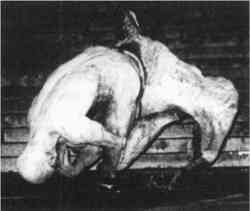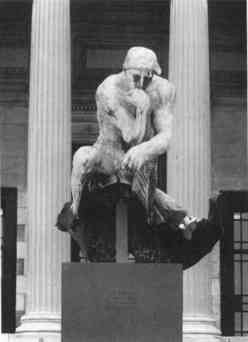TWENTY-FIVE YEARS AFTER THE BOMB: MAINTAINING CLEVELAND'S THE THINKERBRUCE CHRISTMAN
3 EXPLOSION, MARCH 24, 1970In the early morning hours of March 24, 1970, dynamite was placed between the legs of The Thinker. The results were devastating (fig. 3). The base and the lower part of the legs were annihilated, and the remaining sculpture was knocked off of its pedestal. The Thinker lay face down, apparently contemplating Hell much more directly. The blast sent pieces of bronze flying, causing damage to the building approximately 20 yards away. The bronze doors of the museum were dented, and the marble columns were chipped. This damage can be seen to this day. Pieces of bronze were even found on the roof. According to the Cleveland Police Department, this act of terrorism was conducted by a radical Weatherman group operating in Cleveland. Members of the group later moved to New York City, where they were killed making explosives.
The sculpture sustained considerable trauma. The obvious damages mentioned above were the loss of the feet and lower areas of the legs. The seat supporting the figure was severely distorted. The sculpture also sustained damage not so easily seen. The explosion caused much of the lower half of the sculpture to expand and to be A number of treatment options were examined and contemplated by Edward Henning, curator of modern art; Frederick Hollendonner, objects conservator; and Sherman Lee, third director of the museum (April 1958-June 1983). Noted experts, both art historians and conservators, were consulted on the issues surrounding The Thinker. Again, the archives and the curatorial files contain a wealth of information. A number of opinions were expressed, ranging from mounting the object as it was to obtaining a new cast from the Rodin Museum. One of the more knowledgeable and reasoned letters came from Professor Albert Elsen, Stanford University, to Sherman Lee, dated June 18, 1971:
Essentially, the museum studied three treatment options: (1) take molds from other original Thinkers and make a replacement cast; (2) make a cast from molds and cut the newly cast sculpture up to replace damaged areas of the Cleveland sculpture; or (3) mount the damaged sculpture and essentially do no restoration. Joseph Ternbach, a conservator in private practice specializing in metal conservation, acted as a consultant to help study the practicality of the options. Considering the extent of damage and the difficult ethical issues there was no obvious or perfect solution. The making of a new cast after the death of an artist is always problematic. Casting sculptures in bronze is a technique that lends itself to accurate multiple reproductions. The original Thinker owned by the Cleveland Museum of Art was one of the few that had been cast and patinated under the supervision of Rodin. A number of other Thinkers were cast shortly after Rodin's death, and the Rodin Museum continues to make sculptures for sale. At what point does a recast become a reproduction? In Sherman Lee's opinion casting a new sculpture would lack the quality of either the original or even those cast shortly after Rodin's death. It was felt a recast in this situation would in essence be a reproduction. Cutting and welding a new cast to the original were fraught with technical problems. The whole reproduction process of taking a new mold, making a wax model, and casting a new bronze sculpture generally results in significant shrinkage of 5–10%. Matching up parts with different proportions would result in parts that There was also significant distortion of the lower parts of the sculpture, because the explosion expanded the metal in some areas. Even if an exact match in size could be achieved the pieces would not have aligned well due to the changes in the sculpture's dimensions. The other option would have been to cut away the expanded areas of the sculpture in order to achieve a better fit, but significantly more of the original sculpture would be lost. Perhaps less than half of the sculpture would remain. Even if all the technical problems were overcome and the new pieces were matched up to the original sculpture, other ethical issues developed. How far does one take the visual integration of the two parts? Should the new areas be patinated a slightly different color from the original so that viewers could differentiate the original sections from the made-up sections? Would Rodin have approved of the aesthetics of a two-toned sculpture? The last option of mounting the sculpture in its damaged state also had significant ethical implications. This option would preserve what was left of the sculpture directly supervised by Rodin but sacrifice some of the artist's original intent. While Albert Elsen states that Rodin did accept happy accidents in the creative process and used partial sculptures to edit his students' works, there is no clear evidence that he would have been happy leaving the sculpture in its damaged state. It is interesting to reflect that ever since the British Museum mounted the Elgin Marbles as fragments in the 19th century, we have come to accept the concept of a fragment from a sculpture as being a complete work of art. For most classical sculptures we do not know what the original complete sculptures looked like, and doing any type of restoration would be both impossible and unethical. However, the original form of Cleveland's Thinker is well known. The mounting of the sculpture in its damaged state turns The Thinker from being purely an art object into a historical document. For better or worse, an antisocial statement had been made and has now become part of the history of this particular sculpture. As the correspondence in the curatorial files and the archives show, these issues were explored with curators, museum directors, conservators, and artists. After discussing the implications of the three options, the third was selected for a number of reasons. First and foremost, this option preserved what was left of the original sculpture. The first option (making of a new cast) was rejected because it would be a replica and not a cast personally supervised by Rodin. The sculpture had become so distorted by the expansion of the metal during the explosion that the second option could not be seriously considered. Sherman Lee summed up the museum's final position in a letter to Professor Albert Elsen, dated June 15, 1971: The sculpture was then mounted on a bronze armature and placed on a tall granite pedestal with the inscription “The Thinker / by Auguste Rodin / Gift of Ralph King / (and in smaller letters) Damaged 24th of March 1970.” There was little emotional reaction from the press and public to the museum's decision to place the damaged sculpture on view outside the museum (fig. 4). Nearly all of the newspaper
|

